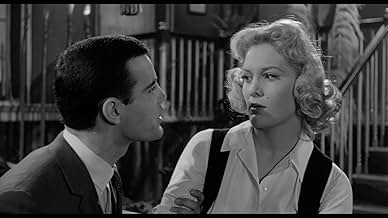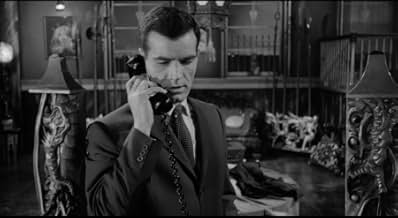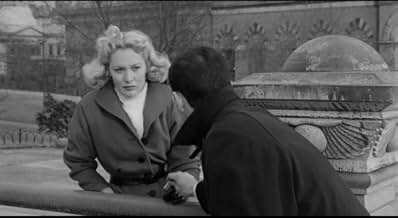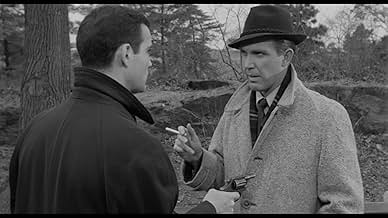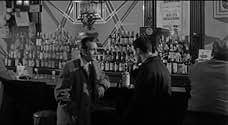Ajouter une intrigue dans votre langueA detective investigating the murder of a heroin addict discovers that there is a connection between the junkie and his fiancee, who is his boss' daughter.A detective investigating the murder of a heroin addict discovers that there is a connection between the junkie and his fiancee, who is his boss' daughter.A detective investigating the murder of a heroin addict discovers that there is a connection between the junkie and his fiancee, who is his boss' daughter.
- Réalisation
- Scénario
- Casting principal
Avis à la une
Gene Milford did not build a household name, even in the realm of B productions like THE PUSHER . I have not seen anything else done by him, but THE PUSHER deserves above average rating.
One curiosity is that 1958 is the year that appears in the opening credits, but IMDB makes it 1960. Was in production for two years? It looks so shoestring that I doubt it, to be honest.
Albeit offering a generally realistic view of New York between those years, the film opens by introducing you to Lt Byrne, his wife, his daughter Laura, and the latter's boyfriend, Steve, also a copper. All, law abiding, all likable... but you discover very rapidly that Laura begins to stray, taking drugs on the quiet. She knows what she is doing, the dangers involved, the impact on her father and boyfriend, and she is convinced she can kick the habit but she just keeps diving deeper into it, getting her stuff from "Ganzo", another name for the pusher, who is very credibly played by prim and proper looking Felice Orlandi.
Of course, moral and family issues rise to the surface, and Lt Byrhe becomes extremely interested in the case when he gets what is happening with Laura and helps her with cold turkey treatment.
It makes you think that by 1958/1960 drug trafficking still seemed a minor and relatively containable problem, and yet since then even the finest police force in the world, US Police, has not managed to reduce it significantly, let alone stop it. And with new drugs being engineered full time, like crack, ecstasy, fentanyl, and all the rest of it, the common citizen has become more and more a target for the panoply of pushers, sellers, and others keeping that infamous trade ticking.
Sadly, by the time this well-meaning, honest film wrapped up, I could only think that mankind heeds no warning, however clear, and in the long run it is condemning itself to extinction for the sake of enriching drug lords.
Strong B noir photography by Arthur Ornitz, credible screenplay by Evan Hunter. 7/10.
One curiosity is that 1958 is the year that appears in the opening credits, but IMDB makes it 1960. Was in production for two years? It looks so shoestring that I doubt it, to be honest.
Albeit offering a generally realistic view of New York between those years, the film opens by introducing you to Lt Byrne, his wife, his daughter Laura, and the latter's boyfriend, Steve, also a copper. All, law abiding, all likable... but you discover very rapidly that Laura begins to stray, taking drugs on the quiet. She knows what she is doing, the dangers involved, the impact on her father and boyfriend, and she is convinced she can kick the habit but she just keeps diving deeper into it, getting her stuff from "Ganzo", another name for the pusher, who is very credibly played by prim and proper looking Felice Orlandi.
Of course, moral and family issues rise to the surface, and Lt Byrhe becomes extremely interested in the case when he gets what is happening with Laura and helps her with cold turkey treatment.
It makes you think that by 1958/1960 drug trafficking still seemed a minor and relatively containable problem, and yet since then even the finest police force in the world, US Police, has not managed to reduce it significantly, let alone stop it. And with new drugs being engineered full time, like crack, ecstasy, fentanyl, and all the rest of it, the common citizen has become more and more a target for the panoply of pushers, sellers, and others keeping that infamous trade ticking.
Sadly, by the time this well-meaning, honest film wrapped up, I could only think that mankind heeds no warning, however clear, and in the long run it is condemning itself to extinction for the sake of enriching drug lords.
Strong B noir photography by Arthur Ornitz, credible screenplay by Evan Hunter. 7/10.
B-movies are sometimes envisaged as an inferior kind of films. No, it means that the production costs are not as elevated as A-movies. If a star actor gets, say, 1 million dollars for a movie, well, some films (without stars) were made with an overall expenditure of less than 1 million. Now, I don't really care about production's costs, and some B-movies are better than the more high-class ones (not this one, I must say).
The strong positive values of "The Pusher", in my opinion, are the well-defined plot, without any confusing sub-plots or blurred images and shots that let you quite uncertain about what has really happened, and the consequent linear execution of it. This is also a detrimental point, because when you reach minute 16th (of the overall 82), you will know exactly how will the narrative develop.
No thrills, consequently, but if you are a lover of the genre you will enjoy this film. I rated it 6; let's say, more precisely, 6 and a half.
The strong positive values of "The Pusher", in my opinion, are the well-defined plot, without any confusing sub-plots or blurred images and shots that let you quite uncertain about what has really happened, and the consequent linear execution of it. This is also a detrimental point, because when you reach minute 16th (of the overall 82), you will know exactly how will the narrative develop.
No thrills, consequently, but if you are a lover of the genre you will enjoy this film. I rated it 6; let's say, more precisely, 6 and a half.
It's a tough look at the grimy side of New York, as the detectives of the 87th Precinct try to crack down on the drug trade.
It's based on Evan Hunter's '87th Precinct' series of novels. with the screenplay written by Harold Robbins. It's got a score by the great Raymond Scott, that varies from jazz to movie bombast -- I don't think it quite works, but you may reasonably disagree. Robert Lansing plays the same character he would in the 1961-1962 TV series, and if you look hard, you may recognize John Astin as one of the detectives in the background.
It's certainly worthy of approval of the tough realism of New York's street and worthy of your at
It's based on Evan Hunter's '87th Precinct' series of novels. with the screenplay written by Harold Robbins. It's got a score by the great Raymond Scott, that varies from jazz to movie bombast -- I don't think it quite works, but you may reasonably disagree. Robert Lansing plays the same character he would in the 1961-1962 TV series, and if you look hard, you may recognize John Astin as one of the detectives in the background.
It's certainly worthy of approval of the tough realism of New York's street and worthy of your at
Another reviewer complained that this wonderful, moody and atmospheric film about heroin addiction was too "dreary.." I have to laugh at some of the comments I read here. New York City, circa 1958; a heroin kingpin sets up shop, and sets himself up in a posh penthouse apartment on Riverside Drive. His customers are mostly kids, many of them Puerto Rican immigrants looking to find their place in a new city, and they get hooked on the smack that Mario supplies them. Things start to get out of control when a Police Lieutenant's daughter gets hooked, while working at a shady nightclub in Midtown. The pusher himself, played by Felice Orlandi, is suitably sleazy and heartless, as he feeds off of the young people in the area, making himself rich while destroying their lives in the process. This film is remarkably realistic in it's depiction of both the business aspect and the addiction aspect of the drug culture. Beautifully filmed in shadowy, stark black and white, with New York City on display in all it's old time glory. Of course it's "dreary," and seedy, and downbeat. This title is very rare and i imagine a copy must be a real collectors item. It reminded me of the New York beat/jazz scene described in Kerouac's "On the Road," so much so, that I half expected William Burroughs to appear in one of those seedy Times Square bars shown in this film. This is a wonderful, lost movie that should be easier to find. Similar to "Hatful of Rain," another early 60's NYC heroin movie, although this one is better. "The Pusher" would make a great double feature with "Who Killed Teddy Bear," which is another 1960's study of the seedy underbelly of New York's times Square scene. A lost gem...
United Artists dumped this lousy movie, understandably since it lacks any entertainment value. As the title suggests, there was exploitation movie material to be mined here, but one-shot movie director Gene Milford (whose day job was film editing) delivered a deadly dull stinker with a no-name cast.
Writing credits are strictly A-list: screenplay by Harold Robbins early in his career, from an Ed McBain novel by Evan Hunter. But they have no feel for the genre. It plays like a reject episode of TV's "Naked City" series, with on-location photography plus chintzy studio interiors.
Cops are played by Robert Lansing and John Astin, also having career off-days. Heroine (who is hooked on perhaps heroin?) Kathy Carlyle is good looking but an instant flop -her only other movie was a routine Charles Bronson war picture.
The title character played by Felice Orlandi is a bore -instantly one-note evil. Addiction then and now is a surefire formula for drama, but Robbins, unlike his future amazing success with so many hit novels like "The Carpetbaggers", comes up with nothing but dullness.
Writing credits are strictly A-list: screenplay by Harold Robbins early in his career, from an Ed McBain novel by Evan Hunter. But they have no feel for the genre. It plays like a reject episode of TV's "Naked City" series, with on-location photography plus chintzy studio interiors.
Cops are played by Robert Lansing and John Astin, also having career off-days. Heroine (who is hooked on perhaps heroin?) Kathy Carlyle is good looking but an instant flop -her only other movie was a routine Charles Bronson war picture.
The title character played by Felice Orlandi is a bore -instantly one-note evil. Addiction then and now is a surefire formula for drama, but Robbins, unlike his future amazing success with so many hit novels like "The Carpetbaggers", comes up with nothing but dullness.
Le saviez-vous
- AnecdotesFilm debut of John Astin.
- ConnexionsFeatured in Frightful Movie: The Pusher (1968)
Meilleurs choix
Connectez-vous pour évaluer et suivre la liste de favoris afin de recevoir des recommandations personnalisées
Détails
- Date de sortie
- Pays d’origine
- Site officiel
- Langue
- Aussi connu sous le nom de
- Narkotika
- Lieux de tournage
- 113 East 115 Street, Ville de New York, New York, États-Unis(Location where Anibal Hernandez's Body was found by Police)
- Société de production
- Voir plus de crédits d'entreprise sur IMDbPro
Box-office
- Montant brut aux États-Unis et au Canada
- 1 656 $US
- Week-end de sortie aux États-Unis et au Canada
- 1 656 $US
- 9 mai 1999
- Montant brut mondial
- 1 656 $US
- Durée
- 1h 21min(81 min)
- Couleur
- Mixage
- Rapport de forme
- 1.37 : 1
Contribuer à cette page
Suggérer une modification ou ajouter du contenu manquant

